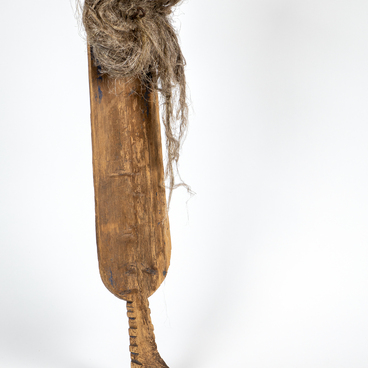The collection of the Sheltozero Veps Ethnographic Museum named after Rurik Petrovich Lonin features antique baby walker donated to the museum by Vyacheslav Vasilyevich Kottin, a resident of the village of Sheltozero. Walkers were used in the ancient house of the Korzins.
Apparently, the walkers, made by an unknown craftsman, were created at home from improvised material. The upper part is made of two boards, in the center there is a round hole with a diameter of 22 centimeters, covered with burlap. The four legs have a downward-expanding shape for greater stability. It is noteworthy that for the legs the craftsman selected suitable tree branches with a slight bend. The sides of the legs are properly sawn off for more comfortable sliding on wooden floorboards. This device for a small child is made so that he or she could grow up healthy and strong, both in body and spirit. From the age of one, children in the family were prepared for adulthood, and their character was formed. The Veps raised strong-willed children.
Until the 1930s, the Veps family was large and
numbered up to 20 people — this is up to four generations. The Veps family had
clear ideas about the need for procreation. A family with children was
considered prosperous, and childlessness was considered a great misfortune.
Infertility was usually blamed on a woman: “A woman has no fruit.” However,
having too many children in the family did not lead to much joy due to
financial difficulties. In general, in Veps families, children were treated
with great tenderness. If the child cried for no reason, the mother blamed
herself for it. She thought she had offended the child in some way. There was
even a text of forgiveness — the mother recited it for three days. Education
was carried out in unquestioning obedience to the elders. In the recent past,
one could hear how the child was affectionately called in the family: č o č o,
punk, punkuine (“baby”, “honey”). Depending on the age, the baby was called
vagaheine (literally “lying in a groove”) — this was how people referred to a
baby who was breastfeeding; dubituz — “a child starting to stand on his feet”
(from “dybki” — feet); k ä p äš — “a child starting to walk” (from “k ä psta” —
“walking slowly, without haste”).


